Ask a question from expert
Managing Successful Business Project: Nestle
39 Pages8516 Words82 Views
Added on 2021-02-22
Managing Successful Business Project: Nestle
Added on 2021-02-22
BookmarkShareRelated Documents
MANAGINGSUCCESSFUL BUSINESSPROJECT

TABLE OF CONTENTSTOPIC:.............................................................................................................................................1INTRODUCTION...........................................................................................................................1Research Background.............................................................................................................1P.1 Aims & Objectives...........................................................................................................1Rationale.................................................................................................................................2Literature Review...................................................................................................................2Selection process ............................................................................................................................3P.2 PROJECT MANAGEMENT PLAN................................................................................4P.3 Work break down Structure, Gantt Chart.........................................................................5..........................................................................................................................................................9........................................................................................................................................................10LO.2...............................................................................................................................................11P4 Questionnaire .................................................................................................................11P.5 DATA ANALYSIS AND INTERPRETATION...........................................................13LO.3...............................................................................................................................................21P.6 RECOMMENDATIONS...............................................................................................21LO.4...............................................................................................................................................21P.7 REFLECTION...............................................................................................................21CONCLUSION..............................................................................................................................22REFERENCES..............................................................................................................................23APPENDIX 1.................................................................................................................................25P7 Log Book –......................................................................................................................25APPENDIX 2.................................................................................................................................35Performance Review............................................................................................................35
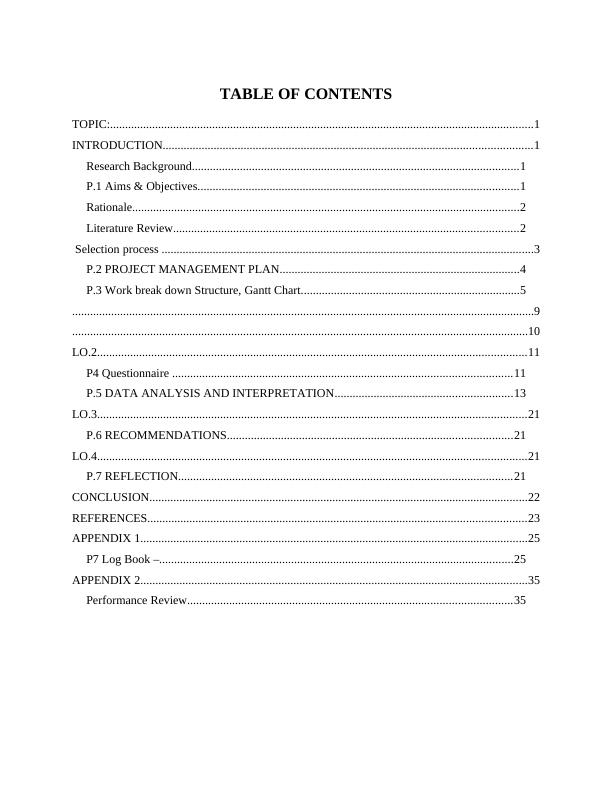
TOPIC:How do multinational companies improve the recruitment, selection andtraining of their employees to meet International requirements?INTRODUCTIONResearch BackgroundGlobalisation can be defined as a process of expanding the business organisationinternationally. It is nothing but a dispersion of various business activities beyond thegeographical areas (Steger, 2017). Globalisation also helps a firm in improving its recruitmentand selection procedure by the way of gathering talent from all over the world for the businessorganisation.The present research report includes research on Nestle. It is a food company thatoperates its business functions in all over the world. Nestle was founded by Herni Netsle in theyear 1866. It operates more than 447 factories in approx 189 countries. Further, it has employedmore than 339000 employees for performing its business operations at global level. As per theprinciples and cultural policies of Nestle, the company has formed numerous policies for itshuman resource management.P.1 Aims & Objectives.Aim:“To explore the importance of recruitment, selection and training of employees of multinationalcompanies to meet international requirements with the emergence of global brands. A study onNestle”.Objectives:To determine the current trends of recruitment, selection and training of employees inbusiness world. To identify the significance of recruitment, selection and training of employees ofmultinational companies after globalisation. 1
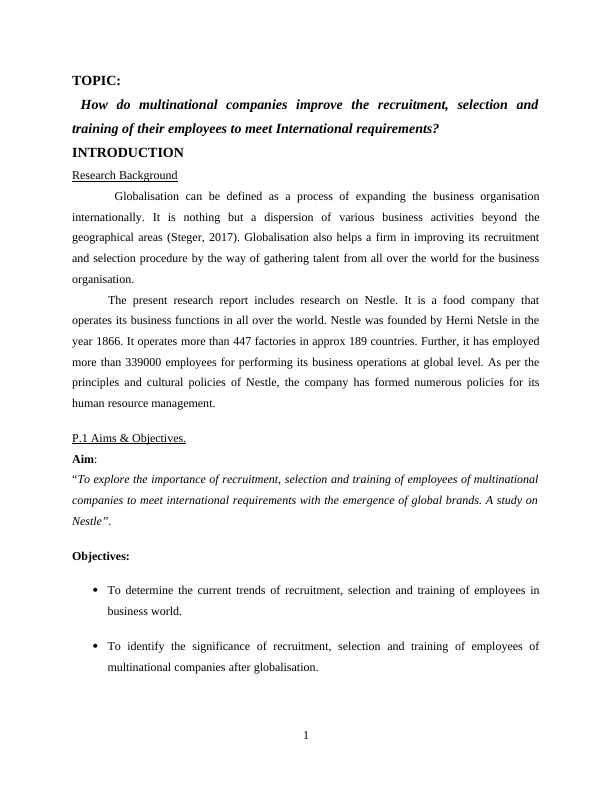
To identify the challenges multinational organisation faced in recruitment, selection andtraining of employees with the emergence of global brands. To provide recommendation for bringing improvement in recruitment, selection andtraining of employees of Nestle.Research Questions:What are the current trends of recruitment, selection and training of employees inbusiness of Neslte. What are the significance of recruitment, selection and training of employees of Nestleafter globalisation?What are the challenges multinational organisation such as Nestle faced in recruitment,selection and training of employees with the emergence of global brands. What are the recommendation for bringing improvement in recruitment, selection andtraining of employees of Nestle.RationaleThe above research has been made on the topic globalisation and its impact on therecruitment and selection process of multinational companies. The major reason behind choosingthis topic was the academic requirement. This research helps in improving the knowledge andunderstanding of the researcher and reader about all the positive impact has been observed overthe recruitment and selection process of multinational companies.Literature ReviewRecruitment processThe Mohammad, (2015) has a view that recruitment is a process of pooling a largenumber of eligible candidates for the vacant position. This process helps managers in steppingforward to the selection of the best employee for vacant position in firm.On thisMelanthiou, Pavlou and Constantinou, (2015) states that recruitment processplays a vital role in the quality of performance of the company. In order to maintain and improve2
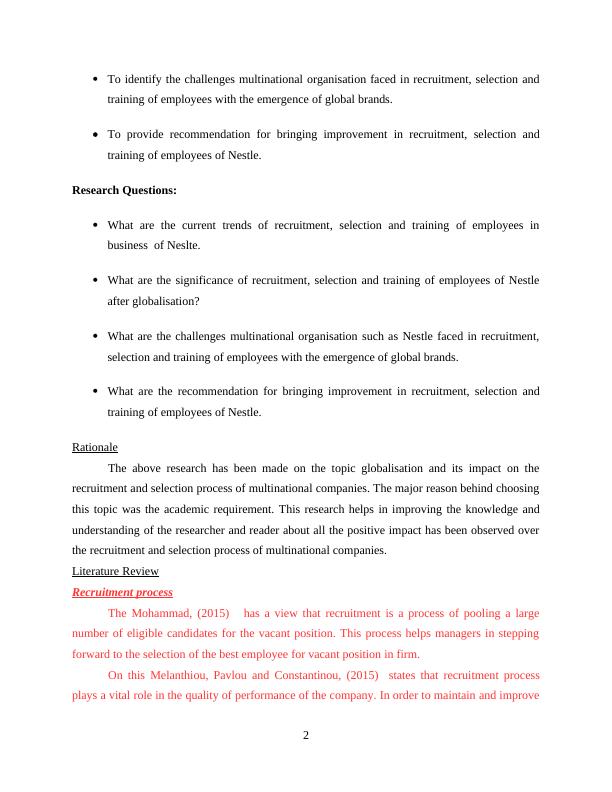
the quality of performance of the company, human resource managers needs to first analyse theneeds and required qualifications of vacant position and should recruit the employeesaccordingly.Selection process As per the views of Bubacz, Rabb and Ringgold, (2019) selection of candidate ends theprocess of recruitment. In this process the most eligible candidate from the pool of recruitedcandidates is selected for vacant position. face to face interviews, eligibility test, GD, personalitytest, are some most commonly used methods in selection process.Further, Haq, (2017)says that as, selection of inappropriate candidate may result in failureof performing any specific tasks to be performed by the individual employed at any position. Inthis regard, inefficiency of human resource managers in selecting the most appropriate employeefor any position in the company may result in declining the efficiency of performance of overallbusiness. Training: According to the Bournois, Chauchat and Roussillon, (2017) training is one of the mostimportant part of the organisation. Better training leads to better processes and more efficientwork. In today's ever changing market, the significance of job training has never been greater. Itis the process of raising the skills, capabilities and knowledge of employees for doing specificjob. However, Larsen, (2017) said that, the process of training moulds the thinking of employeesas well as leads to the quality performance of staff members. Training is said to be the neverending and continuous process. Høyer and et.al., (2017) said that, training improves the moral of human resource of theorganisation as it aids in providing satisfaction and security of job. Further, it is also said that byproviding training to employees, organisation have to acquired trained workforce withinorganisation that save the time of organisation by less supervision. But this statement is arguedby Armstrong and Landers, (2018) training is costly affair for organisation as they have to callexperts and make resources available for organising training that raises the cost of production. Itis is also time consuming activity. Further, Sartori and et.al., (2018) said that, training aids in3

implementing changes within organisation successfully as it is makes the culture of continuousimprovement and welcome changes. P.2 PROJECT MANAGEMENT PLANProject management plan refers to a document that contains summary of variousstrategies, plans and policies developed for the completion of project. It provides informationabout scope, cost, time, risk etc. involved in the performance of project and its effectivemanagement as well. Essential elements of project management plan are as under:Scope: Scope of project management plan shows the limits within which the research ona specific topic can be made (Fewings and Henjewele, 2019). It helps the investigators indetermining the major goals of project. Present research have a scope of both academicand corporate sectors. in this regard, researcher can take reference of various academicbooks and journals along with analysis of various business functions of retail businessunits operating their business at global level as well.Time: This element of plan helps in determining the maximum time of completing eachactivity of the project (10 Essential Elements for the Perfect Project Plan (Infographic).2019). By analysing time of project management plan, project managers becomes able toeffectively analyse in 7 weeks.Cost: It is the most important element of project management plan. It helps the projectmanagers in scheduling each activity of project and developing their controlling measuresto ensure the completion of overall project within the minimum time.About $100 isincluded in this research.Risk: By analysing this element of plan, project managers becomes enable topredetermine all the risks that may occur in the near future such as financialinsufficiency, natural calamities, physical injuries, etc. with the help of this factor, theycan develop their effective strategies and plans in advance so that all the uncertainties canbe eliminated effectively.Communication: It is an important part of project management plan, as it providesinformation about the way through which all the necessary information would beinformed to stakeholders and other key persons. in the present study, communication will4
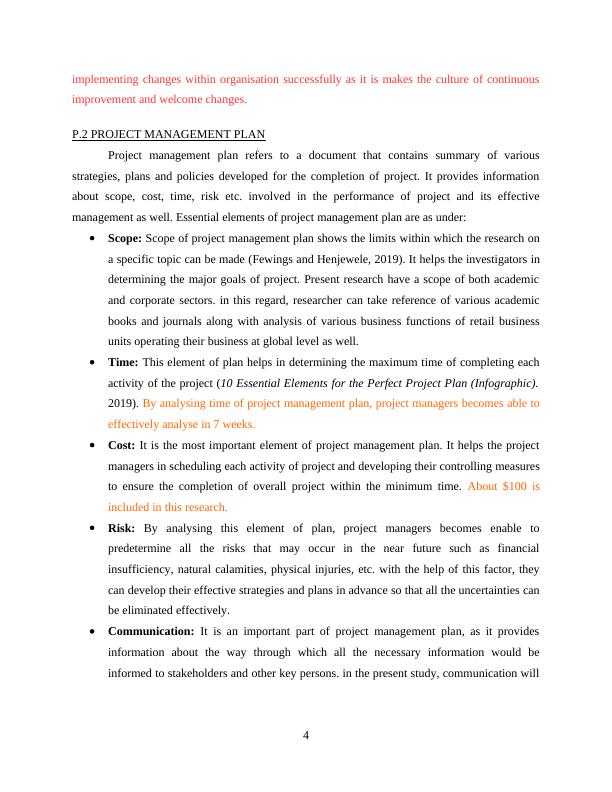
be done through various technical sources such as mail, messages, telecommunicationand circulars.Resources: It contains information about various all the resources that would be neededin the completion of each project activities smoothly (Garwood and Poole, 2018). In thepresent research numerous resources such as human resources, cash and cash equivalents,human resources, books and journals, Stationery, Computer, Support from tutor, laptops,etc. would be needed. Quality: This element of project management plan helps in maintaining viability in theresearch (Fleming, 2019). As per this element the researcher needs to ensure that all thedata collected through various sources must be reliable and must be taken throughauthentic and reliable sources as well.P.3 Work break down Structure, Gantt Chart.RESEARCH METHODOLOGIESResearch methodsResearch methods can be defined as tools and techniques that would be used for makingin-depth study of a specific topic. Majorly qualitative and quantitative tools are being used forthe study purpose. Qualitative tools provides information regarding all characteristics, attributes,properties of the research topic. On the other hand, Quantitative data provides quantifiableresults of the research. In the present research both qualitative and quantitative data has beenused for collecting data and determining results.Research design: Research design helps in making the project report more presentable and easy tounderstand as well. It contains details about all the tools, methods, techniques used for theresearch purpose. Descriptive and experimental research are two major categories of researchdesign. The descriptive research provides information regarding perceptive and characteristics ofthe overall phenomenon on which research has been made (Mishra, 2019). on the other hand,Experimental research provides quantitative information regarding cause and effect on the basisof several statistical tools and methods. In the present report the descriptive research has beenused so that the researcher could effectively analyse the positive or negative impact ofglobalisation over recruitment and selection procedure of the multinational companies.Research approach5

After choosing the appropriate research design, selection of the appropriate research isthe next important task. Choosing the best research approach can help in development ofeffective plans, collection of reliable and appropriate data and proper analysis & interpretation ofcollected data as well. Inductive, and deductive approaches are two main approaches used for theresearch purpose. Deductive approach is based on collection of data and development ofhypothesis or results on the basis of existing theories. Whereas, in inductive theories approach,the researchers do not use any existing theories or pattern. Rather, they observe overall data anddetermines the results on their own. In the present research report, inductive approach has beenused as it is based on various probability measures that helps in studying all the possiblemeasures. it would improve the quality of research. SamplingSampling refers to the population from which the overall data has been collected.Researcher needs to choose appropriate set of population for gathering several data anddetermining the actual results. Chosen of appropriate set of population can improve the reliabilityand viability of results derived from interpretation of collected data (Taylor and Olson, 2019) . Inthe present report, 30 human resource managers of Nestle have been chosen as a sample. Thisselection will help researcher in gathering actual information regarding impact on recruitmentand selection process of Nestle that has been incurred due to globalisation.Data collectionAfter selection of samples, the next step is to collect the data from selected samples.There are two methods of data collection i.e. primary and secondary method. Primary researchrefers to collecting the data directly from the population. survey, questionnaire are majormethods of primary research. Collecting data from several websites, books and journals, etc. areknown as secondary research. This research includes both primary and secondary research.Collecting data from both ways improves the quality and reliability of data.Data analysisData analysis is the process of analysing all the information collected various statisticaltools are being used for analysing the overall data and measuring them for determining the endresults(Abyad, 2019). In this process the data is being transformed through which researchermakes a proper thematic analysis of data and effectively present them by using charts, tables,graphs, etc.6
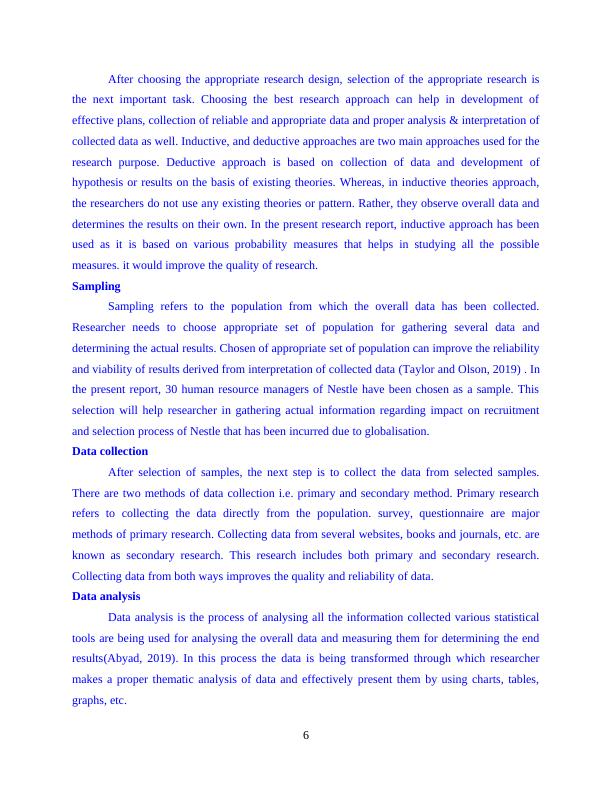
End of preview
Want to access all the pages? Upload your documents or become a member.
Related Documents
Managing a Successful Business Project - Aims and Objectiveslg...
|40
|7316
|27
Managing a Successful Project - Aim and Objectivelg...
|26
|5545
|29
Managing Successful Business Projectlg...
|21
|3742
|41
Recruitment and Selection and Employees Training of Nestle Plclg...
|24
|4662
|255
Managing a Successful Business Project - P1 Aim and Objectiveslg...
|27
|4970
|74
Globalising In the business (pdf)lg...
|35
|4352
|20